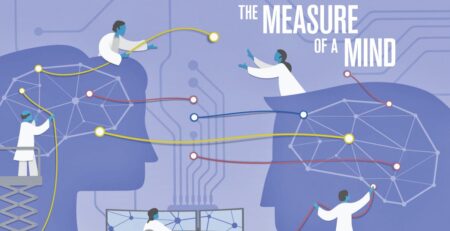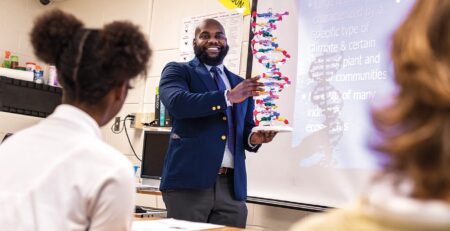written by Jennifer Rainey Marquez
written by Jennifer Rainey Marquez
DO YOU REMEMBER THE DOTTY OLD ENGLISHMAN OF FICTION, Doctor Doolittle, who wandered the world talking to animals?” asks Morley Safer, introducing a “60 Minutes” segment from 1978. “Well, the doctor had realized one of our oldest impossible dreams: that we might one day communicate with species other than ourselves. It seems that the dream is not so impossible.””
The segment focused on what was then a fairly new field of scientific research: the study of ape language. Of the three scientists featured, two had spent years teaching sign language to apes, but one — Duane Rumbaugh, the heavily-sideburned chair of psychology at Georgia State — had taken a different approach. Instead of gestures, he had taught a chimpanzee to communicate using technology.
“You want a tickle?” a bearded young man asks in the video, speaking to the adolescent chimp. “Go ahead,” he prompts, and the chimp slides over to a rectangular board gridded with buttons. She taps out a sequence, and the man grins and grabs her as she playfully tries to escape. “I’ve got you now!” he shouts.
The chimp on the screen is Lana, a 7-year-old female, and she has just used the board to make a request of Tim Gill, a psychologist and member of Rumbaugh’s research team: “Please Tim tickle Lana.” It’s one of several utterances she makes in the segment, prompting Safer to ask Rumbaugh what he sees as the ultimate conclusion of this language training.
“The thought has come to us that it would be very, very beautiful and interesting if someday a language trained chimp could go to the field with an investigator to help with some of the nuances of interpretation,” he says. “But I assure you we’re a long way from being able to do that. Your job is still safe. We won’t see a chimp on ‘60 Minutes’ as an anchorman.”
Left: Lana with an early version of the lexigram keyboard
Right: Lana and Tim Gill, the Ph.D. student who taught her to use the keyboard
In 1969, the year Rumbaugh first came to Georgia as associate director of the Yerkes Regional Primate Research Center at Emory University, two cognitive researchers at the University of Nevada published a report that caught the world’s attention. In it, Allen and Beatrix Gardener detailed their progress teaching American Sign Language to a female chimpanzee named Washoe. Earlier attempts at teaching chimpanzees to speak had failed, but these results were encouraging — after 22 months, Washoe was able to appropriately use 30 signs, often in strings of two or more.
Rumbaugh, then 40, was a comparative psychologist primarily interested in the nature of learning. A few years earlier he had developed an innovative tool called the transfer index, a method of gauging learning ability in any species. As news of the Gardeners’ achievements spread, Rumbaugh wasn’t surprised when his supervisor, Yerkes director Geoffrey Bourne, tasked him with developing a language project with chimpanzees at the primate center.
Rumbaugh was skeptical the animals could succeed in communicating. He felt the Gardeners had made a mistake in assuming Washoe was capable of learning language at all, and he didn’t want to use sign language or other gestures that relied heavily on human interpretation. (Because chimpanzees do not execute signs as crisply as humans, it’s often up to the observer to determine whether chimps are trying to ask for food or simply, say, scratching their ears.)
He began to consider how chimpanzees might communicate without the need for subjective analysis and decided to use one of the decade’s novel developments: a computer keyboard. Rumbaugh and his collaborators developed a series of 25 symbols, or lexigrams, each of which stood for a specific word or phrase: “want,” “piece-of,” “banana.” Rather than remaining in fixed positions, like keys on a typewriter, the lexigrams would be moved around regularly so that the primate would have to recognize the symbol itself, not just its physical location. A computer would monitor and record the subject’s keyboard activity, which Rumbaugh and his team could then analyze.
In 1970, he received a grant from the National Institutes of Health to begin his experiment, and in 1971 he joined Georgia State as the chair of the university’s Psychology Department. That same year, the LANA project commenced, named for its first chimpanzee subject: a 2-year-old female, Lana. (A second subject, a young orangutan named Biji, was also selected.) LANA was also an acronym for “Language ANAlogue,” because Rumbaugh felt the animals might only learn an approximation — or analogue — of true language.
Designed and built with the help of a biomedical engineer at Yerkes, a special keyboard featured colorful Lucite buttons that lit up when pressed. Each key was connected to wires leading to an early “mini” computer, which — though smaller than earlier models — was still the size of a large armoire. Once a key was pushed, its symbol was also projected onto a blank panel just above the keyboard so the primate could “read” what it had communicated. To further eliminate ambiguity, Rumbaugh and his team developed something else the signing chimps had never used: a rudimentary grammar system, dubbed “Yerkish,” by which the symbols could be combined into a variety of stock sentences. (“Please machine give M&M period.”)
Initially, Rumbaugh imagined the LANA project could be completely automated, with the primates interacting solely with the keyboard. The computer would be responsible for determining whether the lexigrams were used in the correct combinations and, if so, automatically fulfilling the subject’s requests: dispensing food, say, or playing music.
In 1972, Lana and Biji were placed with the keyboard in a room whose walls were made of clear Lucite, allowing researchers to observe them easily. Rumbaugh and his team were eager to see what the primates would learn by trial-and-error interaction with the machinery.
Not much happened at first. The orangutan was largely uninterested in the colorful symbols, and when Lana did approach the keyboard, Biji often tried to distract her attention away from it. After a few weeks of this, a decision was made. Biji was sent out, and Ph.D. student and behavior technician Tim Gill was sent in. Inside the Lucite cage, Gill worked with Lana, and in the presence of a teacher and social companion, her progress was swift.
“She figured out, ‘There are things I want to ask him, and there are things he wants to ask me, and I can use the keyboard to do that,’” says David Washburn, professor of psychology at Georgia State who began working with Rumbaugh as a graduate student in 1984. “Still, Duane wanted to reduce the possibility of biased interpretation. He sent Tim in with Lana instead of going in himself. He made her use a discrete response every time. It was very strategic to make it a more rigorous experimental design.”
Lana soon learned to request a number of favorite foods and activities (watching a photo slideshow, receiving a visitor) using the keyboard. She also developed some inventive habits. For instance, she would press the lexigram for “period” — a signal to the computer that a statement was complete — when she had made a grammatical error. The period key would cause the computer to reset, thus “erasing” the incorrect sentence so she could quickly begin again.
In 1969, the year Rumbaugh first came to Georgia as associate director of the Yerkes Regional Primate Research Center at Emory University, two cognitive researchers at the University of Nevada published a report that caught the world’s attention. In it, Allen and Beatrix Gardener detailed their progress teaching American Sign Language to a female chimpanzee named Washoe. Earlier attempts at teaching chimpanzees to speak had failed, but these results were encouraging — after 22 months, Washoe was able to appropriately use 30 signs, often in strings of two or more.
Rumbaugh, then 40, was a comparative psychologist primarily interested in the nature of learning. A few years earlier he had developed an innovative tool called the transfer index, a method of gauging learning ability in any species. As news of the Gardeners’ achievements spread, Rumbaugh wasn’t surprised when his supervisor, Yerkes director Geoffrey Bourne, tasked him with developing a language project with chimpanzees at the primate center.
Rumbaugh was skeptical the animals could succeed in communicating. He felt the Gardeners had made a mistake in assuming Washoe was capable of learning language at all, and he didn’t want to use sign language or other gestures that relied heavily on human interpretation. (Because chimpanzees do not execute signs as crisply as humans, it’s often up to the observer to determine whether chimps are trying to ask for food or simply, say, scratching their ears.)
He began to consider how chimpanzees might communicate without the need for subjective analysis and decided to use one of the decade’s novel developments: a computer keyboard. Rumbaugh and his collaborators developed a series of 25 symbols, or lexigrams, each of which stood for a specific word or phrase: “want,” “piece-of,” “banana.” Rather than remaining in fixed positions, like keys on a typewriter, the lexigrams would be moved around regularly so that the primate would have to recognize the symbol itself, not just its physical location. A computer would monitor and record the subject’s keyboard activity, which Rumbaugh and his team could then analyze.
In 1970, he received a grant from the National Institutes of Health to begin his experiment, and in 1971 he joined Georgia State as the chair of the university’s Psychology Department. That same year, the LANA project commenced, named for its first chimpanzee subject: a 2-year-old female, Lana. (A second subject, a young orangutan named Biji, was also selected.) LANA was also an acronym for “Language ANAlogue,” because Rumbaugh felt the animals might only learn an approximation — or analogue — of true language.
Designed and built with the help of a biomedical engineer at Yerkes, a special keyboard featured colorful Lucite buttons that lit up when pressed. Each key was connected to wires leading to an early “mini” computer, which — though smaller than earlier models — was still the size of a large armoire. Once a key was pushed, its symbol was also projected onto a blank panel just above the keyboard so the primate could “read” what it had communicated. To further eliminate ambiguity, Rumbaugh and his team developed something else the signing chimps had never used: a rudimentary grammar system, dubbed “Yerkish,” by which the symbols could be combined into a variety of stock sentences. (“Please machine give M&M period.”)
Initially, Rumbaugh imagined the LANA project could be completely automated, with the primates interacting solely with the keyboard. The computer would be responsible for determining whether the lexigrams were used in the correct combinations and, if so, automatically fulfilling the subject’s requests: dispensing food, say, or playing music.
In 1972, Lana and Biji were placed with the keyboard in a room whose walls were made of clear Lucite, allowing researchers to observe them easily. Rumbaugh and his team were eager to see what the primates would learn by trial-and-error interaction with the machinery.
Not much happened at first. The orangutan was largely uninterested in the colorful symbols, and when Lana did approach the keyboard, Biji often tried to distract her attention away from it. After a few weeks of this, a decision was made. Biji was sent out, and Ph.D. student and behavior technician Tim Gill was sent in. Inside the Lucite cage, Gill worked with Lana, and in the presence of a teacher and social companion, her progress was swift.
“She figured out, ‘There are things I want to ask him, and there are things he wants to ask me, and I can use the keyboard to do that,’” says David Washburn, professor of psychology at Georgia State who began working with Rumbaugh as a graduate student in 1984. “Still, Duane wanted to reduce the possibility of biased interpretation. He sent Tim in with Lana instead of going in himself. He made her use a discrete response every time. It was very strategic to make it a more rigorous experimental design.”
Lana soon learned to request a number of favorite foods and activities (watching a photo slideshow, receiving a visitor) using the keyboard. She also developed some inventive habits. For instance, she would press the lexigram for “period” — a signal to the computer that a statement was complete — when she had made a grammatical error. The period key would cause the computer to reset, thus “erasing” the incorrect sentence so she could quickly begin again.
In 1973, Rumbaugh and his colleagues published an article describing their experiments with Lana in Science, and like the Washoe study it garnered major attention. Yet many scientists remained unconvinced. The ability to use language has long been considered unique to humans, and critics argued Lana was merely exhibiting rote memorization rather than communicating in a linguistic way.
“The critics’ refrain was, ‘This is not language; this is not interesting,’” says Washburn.
The sign language research endured even harsher criticism. In the mid-1970s, Herbert Terrace, a cognitive researcher at Columbia University, tried to replicate the Gardners’ findings with a chimpanzee named Nim Chimpsky. In a paper published in Science in 1979, Terrace concluded that Nim was not truly engaging in conversation but reacting to prompts and imitating the humans around him.
Terrace’s findings threw the entire field of ape language into question, but the LANA project — thanks to Rumbaugh’s meticulous methodology — managed to weather the controversy.
“[The computer] didn’t care what Lana wanted. It only cared about whether Lana could make the machine work,” says Michael Beran, associate professor of psychology at Georgia State and one of Rumbaugh’s last graduate students. “Those keyboard transcripts were hard evidence. No one could say, ‘Well, you’re just reading in what you wish she was doing.’”
Although many of Lana’s stock sentences were formulaic requests, she also made remarkable progress. In 1974, the New York Times reported that Lana had learned her colors, correctly answering questions like, “What color-of this bowl?” and that through her conversations with Tim, she was able to ask for help in naming new objects. (“Tim give Lana name-of this.”) By the time Lana was 5½, she had mastered more than 100 lexigrams, and the computer was modified to allow her to build sentences up to 10 symbols in length — double the previous maximum of five.
In his 2013 book, “With Apes in Mind,” Rumbaugh noted there were limits to how Lana used language.
“She never exploited the power of her language skills to broaden her understanding of the world,” he wrote. “But Lana certainly did use her skills to solve problems,” for instance asking a human technician to bring her a piece of food after her vending device malfunctioned.
Lana also displayed language skills for which she had no training. Without any instruction, she learned to “read” the strings of lexigrams projected onto the blank panel, which allowed the experimenters to ask her questions. She never comprehended novel requests from humans, but she could combine lexigrams to ask for items that were unfamiliar to her — for instance, referring to a cucumber as “banana which-is green.”
Yet despite Lana’s accomplishments, questions remained about how well she actually understood the meaning of individual symbols. In 1976, the research team, led by Rumbaugh and his then-wife Sue Savage-Rumbaugh, began working with a second generation of apes: two male chimpanzees named Sherman and Austin. Rather than focusing on stock sentences, they emphasized word comprehension. They also taught the chimps to use the symbols to communicate with one another. In one experiment, Austin was given food locked in a box and Sherman access to the key. Using the keyboard, Austin could ask Sherman for the key and share some of the food as a reward.
At the same time, the language work with Lana was winding down. In 1977, she entered the Yerkes Center’s breeding program and later gave birth to an infant. The same year, Rumbaugh published a book summing up the LANA project, in which he argued that Lana demonstrated that “neither the public production of language nor the cognitive prerequisites for this production are uniquely human.”
“Without Lana and her willingness to figure out that computer system and engage with those researchers, I don’t know where we would be. Now you go to a conference and say, ‘Monkeys did a computer test,’ and people don’t even look up. But in those days, that was unheard of.”
Left: Duane Rumbaugh, former chair of the Deparment of Psychology and architect of the LANA project
Right: Sherman and Austin, the project’s second generation of apes
In 1973, Rumbaugh and his colleagues published an article describing their experiments with Lana in Science, and like the Washoe study it garnered major attention. Yet many scientists remained unconvinced. The ability to use language has long been considered unique to humans, and critics argued Lana was merely exhibiting rote memorization rather than communicating in a linguistic way.
“The critics’ refrain was, ‘This is not language; this is not interesting,’” says Washburn.
The sign language research endured even harsher criticism. In the mid-1970s, Herbert Terrace, a cognitive researcher at Columbia University, tried to replicate the Gardners’ findings with a chimpanzee named Nim Chimpsky. In a paper published in Science in 1979, Terrace concluded that Nim was not truly engaging in conversation but reacting to prompts and imitating the humans around him.
Terrace’s findings threw the entire field of ape language into question, but the LANA project — thanks to Rumbaugh’s meticulous methodology — managed to weather the controversy.
“[The computer] didn’t care what Lana wanted. It only cared about whether Lana could make the machine work,” says Michael Beran, associate professor of psychology at Georgia State and one of Rumbaugh’s last graduate students. “Those keyboard transcripts were hard evidence. No one could say, ‘Well, you’re just reading in what you wish she was doing.’”
Although many of Lana’s stock sentences were formulaic requests, she also made remarkable progress. In 1974, the New York Times reported that Lana had learned her colors, correctly answering questions like, “What color-of this bowl?” and that through her conversations with Tim, she was able to ask for help in naming new objects. (“Tim give Lana name-of this.”) By the time Lana was 5½, she had mastered more than 100 lexigrams, and the computer was modified to allow her to build sentences up to 10 symbols in length — double the previous maximum of five.
In his 2013 book, “With Apes in Mind,” Rumbaugh noted there were limits to how Lana used language.
“She never exploited the power of her language skills to broaden her understanding of the world,” he wrote. “But Lana certainly did use her skills to solve problems,” for instance asking a human technician to bring her a piece of food after her vending device malfunctioned.
Lana also displayed language skills for which she had no training. Without any instruction, she learned to “read” the strings of lexigrams projected onto the blank panel, which allowed the experimenters to ask her questions. She never comprehended novel requests from humans, but she could combine lexigrams to ask for items that were unfamiliar to her — for instance, referring to a cucumber as “banana which-is green.”
Yet despite Lana’s accomplishments, questions remained about how well she actually understood the meaning of individual symbols. In 1976, the research team, led by Rumbaugh and his then-wife Sue Savage-Rumbaugh, began working with a second generation of apes: two male chimpanzees named Sherman and Austin. Rather than focusing on stock sentences, they emphasized word comprehension. They also taught the chimps to use the symbols to communicate with one another. In one experiment, Austin was given food locked in a box and Sherman access to the key. Using the keyboard, Austin could ask Sherman for the key and share some of the food as a reward.
At the same time, the language work with Lana was winding down. In 1977, she entered the Yerkes Center’s breeding program and later gave birth to an infant. The same year, Rumbaugh published a book summing up the LANA project, in which he argued that Lana demonstrated that “neither the public production of language nor the cognitive prerequisites for this production are uniquely human.”
“Without Lana and her willingness to figure out that computer system and engage with those researchers, I don’t know where we would be. Now you go to a conference and say, ‘Monkeys did a computer test,’ and people don’t even look up. But in those days, that was unheard of.”

The Language Research Center (LRC) is 10 miles southeast of Georgia State’s downtown Atlanta campus, but it feels a world away. It’s enveloped in dense forest, about a mile beyond an unmarked gate. To get there, you must navigate a long curving road, barely wide enough for two cars to pass in opposite directions, until you reach a cluster of five low-rise buildings constructed of brick, concrete and corrugated metal.
Construction began on the LRC in 1979 after Rumbaugh convinced Georgia State administrators to locate a language research facility on a 55-acre lot in Panthersville that had been donated to the university. In the spring of 1981, he and his collaborators moved in.
In the early days, it was a freewheeling place. The researchers took the primates out of their enclosures and into the forest, where they might encounter squirrels or blackberry bushes or hidden treats. (Staff would sometimes have their commutes delayed by an ape perched atop their car.) In the 1980s, Washburn shared an office with fellow Ph.D. student Bill Hopkins, now a professor of neuroscience at Georgia State — as well as two adult male rhesus monkeys.
“At the end of every day, we were saturated with the strong scent of what we jokingly referred to as eau de macaque,” recalls Hopkins. The original group of animals at the center included Sherman and Austin and later grew to include bonobos, rhesus macaques and capuchin monkeys. Lana remained at Yerkes for a few years more, until Rumbaugh negotiated for her to join the other chimpanzees at the LRC.
“Duane still wanted to find out what Lana could do with this language training that she couldn’t do before in terms of memory and categorization and numerical cognition and so forth,” says Washburn. “But beyond that, he wanted to make sure that she was cared for.” The LRC quickly developed a reputation for its innovative approach to language learning. Important figures — John Lewis, Paul McCartney, even Herb Terrace — traveled to Panthersville to witness the work of Lana and her even more famous successors.
The biggest breakthroughs came when the LRC researchers switched their focus from language training to language learning. A human mother teaches her baby language by conducting a constant one-sided conversation, narrating life as it unfolds. In 1985, a newborn female chimpanzee and bonobo were brought to the LRC and raised in a similar way. Eventually the animals, named Panzee and Panbanisha, were able to demonstrate comprehension of more than 100 English spoken words. Panzee also showed the ability to communicate information about the past, directing humans to find an object in the woods days after watching it being hidden.
Around the same time, a male bonobo named Kanzi became a media star when he shattered expectations of what primates could accomplish when reared in a language-saturated environment. Kanzi’s abilities were discovered by accident when he began spontaneously communicating with researchers after watching them try to teach language to his adoptive mother. Kanzi eventually learned hundreds of lexigrams and was able to comprehend not just spoken words but sentences he’d never heard before. He could use his keyboard to request cooking videos — he even learned to make some of his favorite foods — or to visit other apes or places in the forest.
Findings from the LANA project also generated a new approach to help people with cognitive disabilities communicate. In 1975, Rumbaugh initiated a feasibility study to determine whether the computer system and methodology created for the project could be applied to another group: humans who did not speak.
The researchers invited a small group of children from the Georgia Retardation Center, at the time part of the state’s Department of Human Resources, to participate. The children had severe developmental delays and had failed to master even basic language skills using any other program, including sign language. They were taught the same vocabulary and “stock” sentences Lana had been taught and — using the keyboard — learned to request rewards, ask for help and carry on simple conversations.
In 1981, MaryAnn Romski and Rose Sevcik, now Georgia State Regents’ Professors, applied lessons from the second phase of the ape language project to their work with young adults living at the Developmental Learning Center of the Georgia Regional Hospital. Participants gradually built comprehension of individual symbols and their meanings, eventually formulating and initiating their own communications.
“Rumbaugh always wanted his basic research to be translated into meaningful outcomes — and it was,” says Romski.

The Language Research Center (LRC) is 10 miles southeast of Georgia State’s downtown Atlanta campus, but it feels a world away. It’s enveloped in dense forest, about a mile beyond an unmarked gate. To get there, you must navigate a long curving road, barely wide enough for two cars to pass in opposite directions, until you reach a cluster of five low-rise buildings constructed of brick, concrete and corrugated metal.
Construction began on the LRC in 1979 after Rumbaugh convinced Georgia State administrators to locate a language research facility on a 55-acre lot in Panthersville that had been donated to the university. In the spring of 1981, he and his collaborators moved in.
In the early days, it was a freewheeling place. The researchers took the primates out of their enclosures and into the forest, where they might encounter squirrels or blackberry bushes or hidden treats. (Staff would sometimes have their commutes delayed by an ape perched atop their car.) In the 1980s, Washburn shared an office with fellow Ph.D. student Bill Hopkins, now a professor of neuroscience at Georgia State — as well as two adult male rhesus monkeys.
“At the end of every day, we were saturated with the strong scent of what we jokingly referred to as eau de macaque,” recalls Hopkins. The original group of animals at the center included Sherman and Austin and later grew to include bonobos, rhesus macaques and capuchin monkeys. Lana remained at Yerkes for a few years more, until Rumbaugh negotiated for her to join the other chimpanzees at the LRC.
“Duane still wanted to find out what Lana could do with this language training that she couldn’t do before in terms of memory and categorization and numerical cognition and so forth,” says Washburn. “But beyond that, he wanted to make sure that she was cared for.” The LRC quickly developed a reputation for its innovative approach to language learning. Important figures — John Lewis, Paul McCartney, even Herb Terrace — traveled to Panthersville to witness the work of Lana and her even more famous successors.
The biggest breakthroughs came when the LRC researchers switched their focus from language training to language learning. A human mother teaches her baby language by conducting a constant one-sided conversation, narrating life as it unfolds. In 1985, a newborn female chimpanzee and bonobo were brought to the LRC and raised in a similar way. Eventually the animals, named Panzee and Panbanisha, were able to demonstrate comprehension of more than 100 English spoken words. Panzee also showed the ability to communicate information about the past, directing humans to find an object in the woods days after watching it being hidden.
Around the same time, a male bonobo named Kanzi became a media star when he shattered expectations of what primates could accomplish when reared in a language-saturated environment. Kanzi’s abilities were discovered by accident when he began spontaneously communicating with researchers after watching them try to teach language to his adoptive mother. Kanzi eventually learned hundreds of lexigrams and was able to comprehend not just spoken words but sentences he’d never heard before. He could use his keyboard to request cooking videos — he even learned to make some of his favorite foods — or to visit other apes or places in the forest.
Findings from the LANA project also generated a new approach to help people with cognitive disabilities communicate. In 1975, Rumbaugh initiated a feasibility study to determine whether the computer system and methodology created for the project could be applied to another group: humans who did not speak.
The researchers invited a small group of children from the Georgia Retardation Center, at the time part of the state’s Department of Human Resources, to participate. The children had severe developmental delays and had failed to master even basic language skills using any other program, including sign language. They were taught the same vocabulary and “stock” sentences Lana had been taught and — using the keyboard — learned to request rewards, ask for help and carry on simple conversations.
In 1981, MaryAnn Romski and Rose Sevcik, now Georgia State Regents’ Professors, applied lessons from the second phase of the ape language project to their work with young adults living at the Developmental Learning Center of the Georgia Regional Hospital. Participants gradually built comprehension of individual symbols and their meanings, eventually formulating and initiating their own communications.
“Rumbaugh always wanted his basic research to be translated into meaningful outcomes — and it was,” says Romski.
In the 20 years Rumbaugh spent as director of the LRC, he was a constant presence. His house abutted the property, and he would drive by each day on his way to and from the university’s downtown campus. The LRC is staffed 24 hours a day, 365 days a year, and even on holidays, he liked to pop in to check on the humans and the animals.
In 1996, shortly after he joined the LRC, senior research scientist Charles Menzel was working at the facility on Thanksgiving Day. At noon, Rumbaugh appeared to round up the staff for lunch at his favorite spot, the Picadilly Cafeteria in nearby Decatur.
At the end of the meal, as the group prepared to leave, Rumbaugh instructed the group to load up to-go boxes for each of the apes.
“I was halfway across the restaurant when Duane shouted out, ‘And don’t skimp on the gravy!’” says Menzel.
Rumbaugh liked to pick the brains of not just other research faculty but also graduate students and care staff. “One of the unique things about the LRC was that the line between research and animal care was always blurred,” says Washburn, who was appointed director after Rumbaugh retired in 2001. “Everybody took care of the animals. Everybody helped gather data for the research. Duane knew that you had to lay that foundation with the animals in order to discover what they could do, what the interesting questions would be.”
Rather than subjects to be observed, Rumbaugh had always viewed the animals as active participants in the process, almost like colleagues. To coax out their best work, as Tim had done with Lana, the researchers had to develop good relationships with the primates. And you couldn’t do that by delegating all of their care.
“The chimpanzees and other primates are never deprived of food or other necessities in order to induce them to complete a task,” says Washburn. “So how do you get them to participate? You earn their trust.”
Lana died in November 2016 at the age of 46. Her cognitive feats did not end with the lexigrams. Washburn estimates Lana was studied by more than 100 scientists and produced data for more than 200 journal articles and book chapters. After arriving at the LRC, she learned to count, and when shown a numeral, she could use a joystick to remove the corresponding number of boxes from a screen. In 2000, Michael Beran found that she could still recall the original lexigrams — nearly 20 years after she had last seen them.
Although the subsequent generations of apes greatly outperformed Lana in their capacity to learn language, Rumbaugh often reminded people it was only because of her that the research was possible. It was only because of Lana that they even knew to ask these questions.
“Without Lana and her willingness to figure out that computer system and engage with those researchers, I don’t know where we would be,” says Washburn. “Now you go to a conference and say, ‘Monkeys did a computer test,’ and people don’t even look up. But in those days, that was unheard of. Had Duane said, ‘Well, the critics are really on us. Let’s shift back to something that’s a little less controversial,’ I think it’s very possible we would not be talking about the fact that these animals can comprehend human speech, make novel requests and respond to questions.”
A BRIEF HISTORY OF THE LANA PROJECT
1969
Duane Rumbaugh leaves San Diego State University to join Yerkes Regional Primate Research Center at Emory.
October 1970
Lana is born at Yerkes.
1971
Rumbaugh becomes chair of Georgia State University’s Department of Psychology. The LANA project begins, funded with a grant from the National Institutes of Health.
1973
Science publishes an article describing the language experiments with Lana.
March 1974
Time magazine publishes an article about the project, “Lessons for Lana.” Two months later, the New York Times publishes “Computer Helps Chimpanzees Learn to Read, Write and ‘Talk’ to Humans.”
1975
Rumbaugh initiates a feasibility study to determine whether the lexigram keyboard could be used to teach brain-damaged and cognitively impaired humans to communicate.
1976
The second phase of the ape language project begins with two male chimps: Sherman and Austin.
1978
“60 Minutes” airs a segment featuring the LANA project.
1979
Construction begins on the Language Research Center in Panthersville.
1981
The LRC officially opens. Researchers begin working with young adults who do not speak using methods from the chimpanzee language project.
2000
Lana demonstrates she still has excellent recall of the original lexigram symbols.
2001
Rumbaugh retires, and David Washburn is named director of the LRC.
November 2016
Lana dies at the age of 46.
June 2017
Rumbaugh dies at the age of 87.
Duane Rumbaugh died just a few months after Lana on June 23, 2017. Among his former students and collaborators, he is remembered as much for his support and mentorship as for his visionary approach to language research. At one of the last conferences Rumbaugh attended, Beran recalls he passed around his phone and asked other attendees to record themselves talking about their research, so he could go back and listen to it later.
“He was a giant in the field,” says Beran. “But he was always so much more interested in what other people thought about the animals and what they were doing than he was in talking about himself.”
The LRC no longer houses great apes — the last chimp living there, Sherman, died in early 2018 — and, in fact, is no longer focused on the acquisition of language. These days its researchers are answering questions about how primates remember information or their ability to cooperate. Yet the LRC remains infused with the legacy of Rumbaugh and the LANA project, which had a profound impact on the field of ape research, pioneered a computer-based communication system still in use today and shone a spotlight on Georgia State at a time when its research program was in a nascent phase.
At the LRC’s ribbon-cutting ceremony, Rumbaugh handed out buttons bearing the center’s motto, which is also printed on the dedication plaque: “So that together we might learn of language.” The “together” refers to not only collaboration between researchers, but also what Rumbaugh saw as the collaboration among the scientists and the apes.
“Who is my best chimpanzee confidant, my consult?” Rumbaugh writes in his 2013 book, “With Apes in Mind.” “It’s Lana. She was and is the grandmother of all of my professional life. She has taken me hand in hand and led the way.”
The Language Research Center (LRC) is 10 miles southeast of Georgia State’s downtown Atlanta campus, but it feels a world away. It’s enveloped in dense forest, about a mile beyond an unmarked gate. To get there, you must navigate a long curving road, barely wide enough for two cars to pass in opposite directions, until you reach a cluster of five low-rise buildings constructed of brick, concrete and corrugated metal.
Construction began on the LRC in 1979 after Rumbaugh convinced Georgia State administrators to locate a language research facility on a 55-acre lot in Panthersville that had been donated to the university. In the spring of 1981, he and his collaborators moved in.
In the early days, it was a freewheeling place. The researchers took the primates out of their enclosures and into the forest, where they might encounter squirrels or blackberry bushes or hidden treats. (Staff would sometimes have their commutes delayed by an ape perched atop their car.) In the 1980s, Washburn shared an office with fellow Ph.D. student Bill Hopkins, now a professor of neuroscience at Georgia State — as well as two adult male rhesus monkeys.
“At the end of every day, we were saturated with the strong scent of what we jokingly referred to as eau de macaque,” recalls Hopkins. The original group of animals at the center included Sherman and Austin and later grew to include bonobos, rhesus macaques and capuchin monkeys. Lana remained at Yerkes for a few years more, until Rumbaugh negotiated for her to join the other chimpanzees at the LRC.
“Duane still wanted to find out what Lana could do with this language training that she couldn’t do before in terms of memory and categorization and numerical cognition and so forth,” says Washburn. “But beyond that, he wanted to make sure that she was cared for.” The LRC quickly developed a reputation for its innovative approach to language learning. Important figures — John Lewis, Paul McCartney, even Herb Terrace — traveled to Panthersville to witness the work of Lana and her even more famous successors.
The biggest breakthroughs came when the LRC researchers switched their focus from language training to language learning. A human mother teaches her baby language by conducting a constant one-sided conversation, narrating life as it unfolds. In 1985, a newborn female chimpanzee and bonobo were brought to the LRC and raised in a similar way. Eventually the animals, named Panzee and Panbanisha, were able to demonstrate comprehension of more than 100 English spoken words. Panzee also showed the ability to communicate information about the past, directing humans to find an object in the woods days after watching it being hidden.
Around the same time, a male bonobo named Kanzi became a media star when he shattered expectations of what primates could accomplish when reared in a language-saturated environment. Kanzi’s abilities were discovered by accident when he began spontaneously communicating with researchers after watching them try to teach language to his adoptive mother. Kanzi eventually learned hundreds of lexigrams and was able to comprehend not just spoken words but sentences he’d never heard before. He could use his keyboard to request cooking videos — he even learned to make some of his favorite foods — or to visit other apes or places in the forest.
Findings from the LANA project also generated a new approach to help people with cognitive disabilities communicate. In 1975, Rumbaugh initiated a feasibility study to determine whether the computer system and methodology created for the project could be applied to another group: humans who did not speak.
The researchers invited a small group of children from the Georgia Retardation Center, at the time part of the state’s Department of Human Resources, to participate. The children had severe developmental delays and had failed to master even basic language skills using any other program, including sign language. They were taught the same vocabulary and “stock” sentences Lana had been taught and — using the keyboard — learned to request rewards, ask for help and carry on simple conversations.
In 1981, MaryAnn Romski and Rose Sevcik, now Georgia State Regents’ Professors, applied lessons from the second phase of the ape language project to their work with young adults living at the Developmental Learning Center of the Georgia Regional Hospital. Participants gradually built comprehension of individual symbols and their meanings, eventually formulating and initiating their own communications.
“Rumbaugh always wanted his basic research to be translated into meaningful outcomes — and it was,” says Romski.
In the 20 years Rumbaugh spent as director of the LRC, he was a constant presence. His house abutted the property, and he would drive by each day on his way to and from the university’s downtown campus. The LRC is staffed 24 hours a day, 365 days a year, and even on holidays, he liked to pop in to check on the humans and the animals.
In 1996, shortly after he joined the LRC, senior research scientist Charles Menzel was working at the facility on Thanksgiving Day. At noon, Rumbaugh appeared to round up the staff for lunch at his favorite spot, the Picadilly Cafeteria in nearby Decatur.
At the end of the meal, as the group prepared to leave, Rumbaugh instructed the group to load up to-go boxes for each of the apes.
“I was halfway across the restaurant when Duane shouted out, ‘And don’t skimp on the gravy!’” says Menzel.
Rumbaugh liked to pick the brains of not just other research faculty but also graduate students and care staff. “One of the unique things about the LRC was that the line between research and animal care was always blurred,” says Washburn, who was appointed director after Rumbaugh retired in 2001. “Everybody took care of the animals. Everybody helped gather data for the research. Duane knew that you had to lay that foundation with the animals in order to discover what they could do, what the interesting questions would be.”
Rather than subjects to be observed, Rumbaugh had always viewed the animals as active participants in the process, almost like colleagues. To coax out their best work, as Tim had done with Lana, the researchers had to develop good relationships with the primates. And you couldn’t do that by delegating all of their care.
“The chimpanzees and other primates are never deprived of food or other necessities in order to induce them to complete a task,” says Washburn. “So how do you get them to participate? You earn their trust.”
Lana died in November 2016 at the age of 46. Her cognitive feats did not end with the lexigrams. Washburn estimates Lana was studied by more than 100 scientists and produced data for more than 200 journal articles and book chapters. After arriving at the LRC, she learned to count, and when shown a numeral, she could use a joystick to remove the corresponding number of boxes from a screen. In 2000, Michael Beran found that she could still recall the original lexigrams — nearly 20 years after she had last seen them.
Although the subsequent generations of apes greatly outperformed Lana in their capacity to learn language, Rumbaugh often reminded people it was only because of her that the research was possible. It was only because of Lana that they even knew to ask these questions.
“Without Lana and her willingness to figure out that computer system and engage with those researchers, I don’t know where we would be,” says Washburn. “Now you go to a conference and say, ‘Monkeys did a computer test,’ and people don’t even look up. But in those days, that was unheard of. Had Duane said, ‘Well, the critics are really on us. Let’s shift back to something that’s a little less controversial,’ I think it’s very possible we would not be talking about the fact that these animals can comprehend human speech, make novel requests and respond to questions.”
Duane Rumbaugh died just a few months after Lana on June 23, 2017. Among his former students and collaborators, he is remembered as much for his support and mentorship as for his visionary approach to language research. At one of the last conferences Rumbaugh attended, Beran recalls he passed around his phone and asked other attendees to record themselves talking about their research, so he could go back and listen to it later.
“He was a giant in the field,” says Beran. “But he was always so much more interested in what other people thought about the animals and what they were doing than he was in talking about himself.”
The LRC no longer houses great apes — the last chimp living there, Sherman, died in early 2018 — and, in fact, is no longer focused on the acquisition of language. These days its researchers are answering questions about how primates remember information or their ability to cooperate. Yet the LRC remains infused with the legacy of Rumbaugh and the LANA project, which had a profound impact on the field of ape research, pioneered a computer-based communication system still in use today and shone a spotlight on Georgia State at a time when its research program was in a nascent phase.
At the LRC’s ribbon-cutting ceremony, Rumbaugh handed out buttons bearing the center’s motto, which is also printed on the dedication plaque: “So that together we might learn of language.” The “together” refers to not only collaboration between researchers, but also what Rumbaugh saw as the collaboration among the scientists and the apes.
“Who is my best chimpanzee confidant, my consult?” Rumbaugh writes in his 2013 book, “With Apes in Mind.” “It’s Lana. She was and is the grandmother of all of my professional life. She has taken me hand in hand and led the way.”
A BRIEF HISTORY OF THE LANA PROJECT
1969
Duane Rumbaugh leaves San Diego State University to join Yerkes Regional Primate Research Center at Emory.
October 1970
Lana is born at Yerkes.
1971
Rumbaugh becomes chair of Georgia State University’s Department of Psychology. The LANA project begins, funded with a grant from the National Institutes of Health.
1973
Science publishes an article describing the language experiments with Lana.
March 1974
Time magazine publishes an article about the project, “Lessons for Lana.” Two months later, the New York Times publishes “Computer Helps Chimpanzees Learn to Read, Write and ‘Talk’ to Humans.”
1975
Rumbaugh initiates a feasibility study to determine whether the lexigram keyboard could be used to teach brain-damaged and cognitively impaired humans to communicate.
1976
The second phase of the ape language project begins with two male chimps: Sherman and Austin.
1978
“60 Minutes” airs a segment featuring the LANA project.
1979
Construction begins on the Language Research Center in Panthersville.
1981
The LRC officially opens. Researchers begin working with young adults who do not speak using methods from the chimpanzee language project.
2000
Lana demonstrates she still has excellent recall of the original lexigram symbols.
2001
Rumbaugh retires, and David Washburn is named director of the LRC.
November 2016
Lana dies at the age of 46.
June 2017
Rumbaugh dies at the age of 87.
Each year, Georgia State University recognizes an outstanding graduate student or first-year postdoctoral fellow with the Duane M. Rumbaugh Fellowship, which was established in 2002 in honor of the LRC’s founding director. To give to the Rumbaugh Fellowship, go to https://netcommunity.gsu.edu/make-a-gift, click “Find My Fund,” and enter “Rumbaugh” in the fund description search.












Leave a Reply